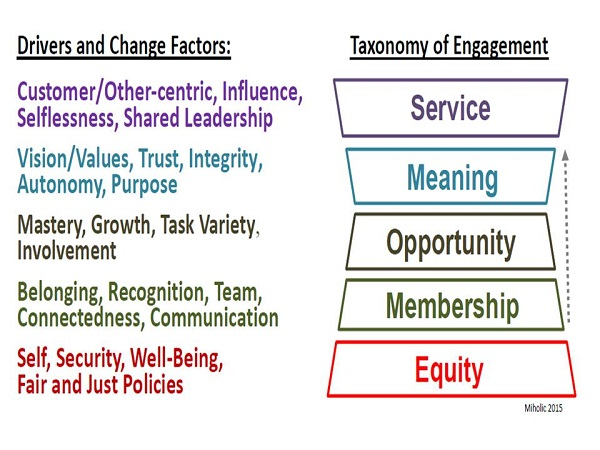ATD Blog
Taxonomy of Engagement: Service Is the Highest Level
Tue Jun 30 2015

The first post in this blog series introduced a hierarchy of engagement, which suggests leaders can significantly move the engagement needle by progressing from basic needs and selfishness (and entitlements) to growth and selflessness. In this manner, the path to stimulating engagement begins with equity and ends with service. In fact, meeting very basic needs (equity) requires the consistent practice of membership, opportunity, and meaning, as well as management at the highest level (service to others).

Level 5: Service
If equity, membership, and opportunity are attended to by leaders in an organization, employee engagement can move from survival (namely self and ambition) toward aspiration and inspiring others. Indeed, actualization of the highest level is significantly transformational.
Equity reflects organizational values in everyday operations, decision making, or communication. Not surprisingly, this engagement taxonomy shares two common derailers articulated by Lencioni five dysfunctions of a team: the first dysfunction is absence of trust, and the second is the preponderance of ego.
To better understand how this second derailer, consider these examples of extremes: 1) Selfish, Kim Kardashian’s book of selfies, and 2) the book, Mother Teresa CEO, Unexpected Principles and Practical Leadership.
To many, leadership and followership are synonymous. However, the energy of humble, giving leaders is inherited and continues to fuel productivity unabated with quiet yet appreciative fanfare. Self-serving leaders are exothermic (consuming the energy around them) and their followers are likely superficial, toxic, and self-limiting. Workers entrenched in “what’s in it for me,” title, strict adherence to compliant behavior, and other external drivers have probably not moved far beyond equity on the taxonomy. More importantly, they will find the journey to service extremely difficult.
No matter the occupation, collective purpose and real service are typically lost in competition and self-indulgence (many advance but do not grow). Service is as much learned as it is an intrinsic disposition, and 100 percent engagement is a noble but unrealistic goal. Consider the quote from Jim Collins in Good to Great, “Good to great leaders never aspired to be put on a pedestal or become unreachable icons.”
In addition, basic laws of physics do not apply to the workplace: Energy can be created and destroyed. What’s more, the energy expended to build towering engagement can quickly crumble if its pillars sit in shallow, soft ground, or a glimmering facade is fastened to questionable scaffolding. Fuller engagement is more likely to occur when organizations:
choose to loosen bureaucratic constraints that subvert shared leadership
discard blame by allowing guided regulation and growth from mistakes or failures
realize that “empire building” is inversely related to effective succession
cultivate initiative versus exercising control, and more equitably share the fruits of success.
Bottom Line
Engagement becomes everyone’s responsibility when workplace conditions and processes share governance, allow risk-taking, promote opportunities, and encourage initiative. As work flow dynamics are inextricably linked to engagement, from hiring to stakeholding to succession, this taxonomy of engagement can help leaders understand how they can truly make a difference in their organizations and assess performance.
Here’s a series of quotes to gauge your progress along the hierarchy:
Equity: “I’ve learned that people will forget what you said, people will forget what you did, but people will never forget how you made them feel.”—Maya Angelou
Membership: “The utmost form of respect is to give sincerely of your presence.”—Mollie Marti
Opportunity: “A good leader takes a little more than his share of the blame, and a little less than his share of the credit.”—Arnold H. Glasgow
Meaning: “What difference will you make? What will be your legacy?”—James Kouszes and Barry Posner
Service: “True leadership must be for the benefit of the followers, not to enrich the leader.”—John Maxwell
